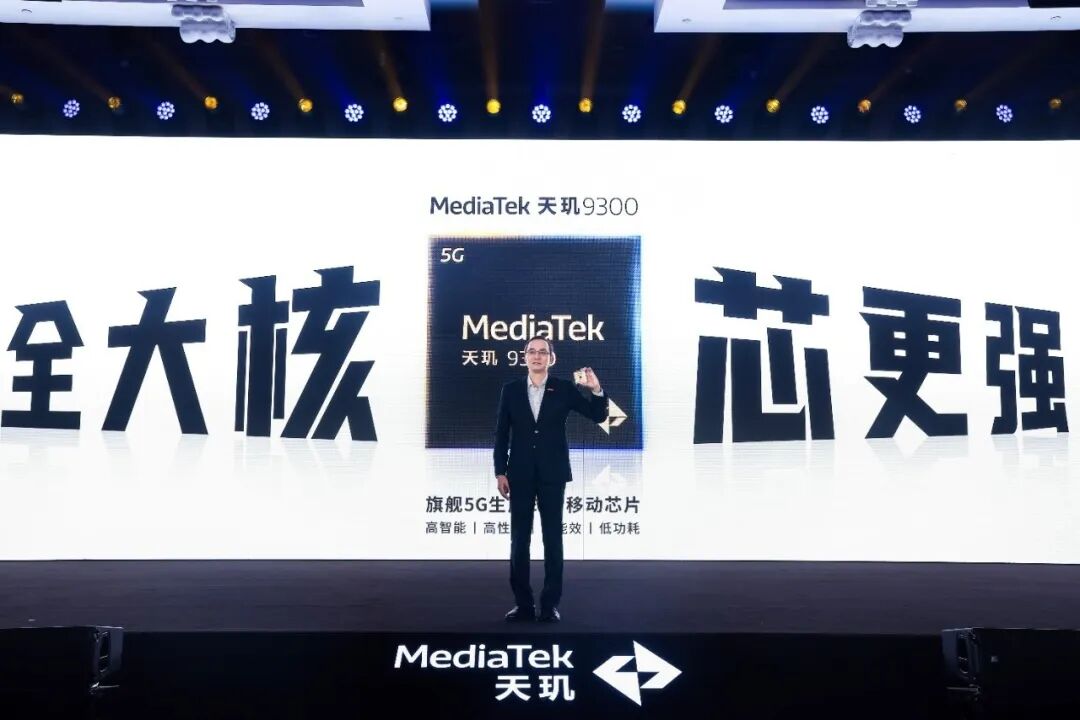
Why does “All Big Cores” represent a new direction for flagship chip performance?
Author: Su YiEditor: Zi QiIn 2023, the smartphone industry is entering a critical period.On one hand, the smartphone market continues to bottom out, but the trend has significantly slowed. After the Chinese smartphone market recorded its “lowest sales in a decade” in the second quarter, the third quarter saw a year-on-year decline of 3% (according to Counterpoint Research), with the decline rate significantly narrowing, indicating that the smartphone market has bottomed out after six consecutive years of decline.On the other hand, the replacement cycle for Chinese users has reached 43 months, setting a new historical high.How to reignite user enthusiasm for upgrading is crucial for major smartphone companies, but the core issues remain: how to significantly accelerate the pace of innovation in smartphone products and how to address the “performance bottleneck” of smartphones.The former has been evidenced by the “counter-cyclical explosive growth” of foldable smartphones: users do not lack the desire to upgrade, but the innovation of smartphone products has not met user expectations. According to data from multiple market agencies, following a 300% growth in the foldable smartphone market in China in 2022, over 3 million foldable units have been sold in the first eight months of this year, surpassing last year’s total.The latter faces even greater challenges: in recent years, mobile chip performance has been claimed to be “advancing by leaps and bounds”, but for both users and smartphone manufacturers, performance seems to be “far from sufficient”.The reasons behind this are very complex.From the user’s perspective, high-load mobile applications such as mobile games are becoming increasingly popular, and the demand for multitasking and cross-screen collaboration in mobile office scenarios is rising. The scenarios in which smartphones need to respond to high performance are becoming more complex, and the rapid growth of foldable screens has further amplified the performance bottleneck effect.More importantly, with the rise of large AI models, as major smartphone manufacturers compete in edge-side large model innovation and application, “performance” has once again become the “Achilles’ heel” in promoting the popularization of AI large models in smartphones.Of course, from the perspective of the manufacturing process itself, after entering the 5nm process, the continued evolution of process technology faces not only high costs and low yields but also “leakage” as the biggest technical challenge. The result is that the pursuit of higher processes has significantly slowed down from chip manufacturers to smartphone companies, while the clock speed of the “big cores” representing performance can only be “squeezed out generation by generation”.How to help smartphones overcome the “performance bottleneck” and push the smartphone industry into a “new round of innovation cycle”, thereby driving the technical ideals of AI edge-side large models into mass popularity, has become a core proposition of common concern and reflection for the entire smartphone industry.The recently released Dimensity 9300 processor is MediaTek’s breakthrough from traditional chip design thinking, providing a “disruptive new answer” to the “performance breakthrough” in the smartphone industry through the “All Big Core” architecture.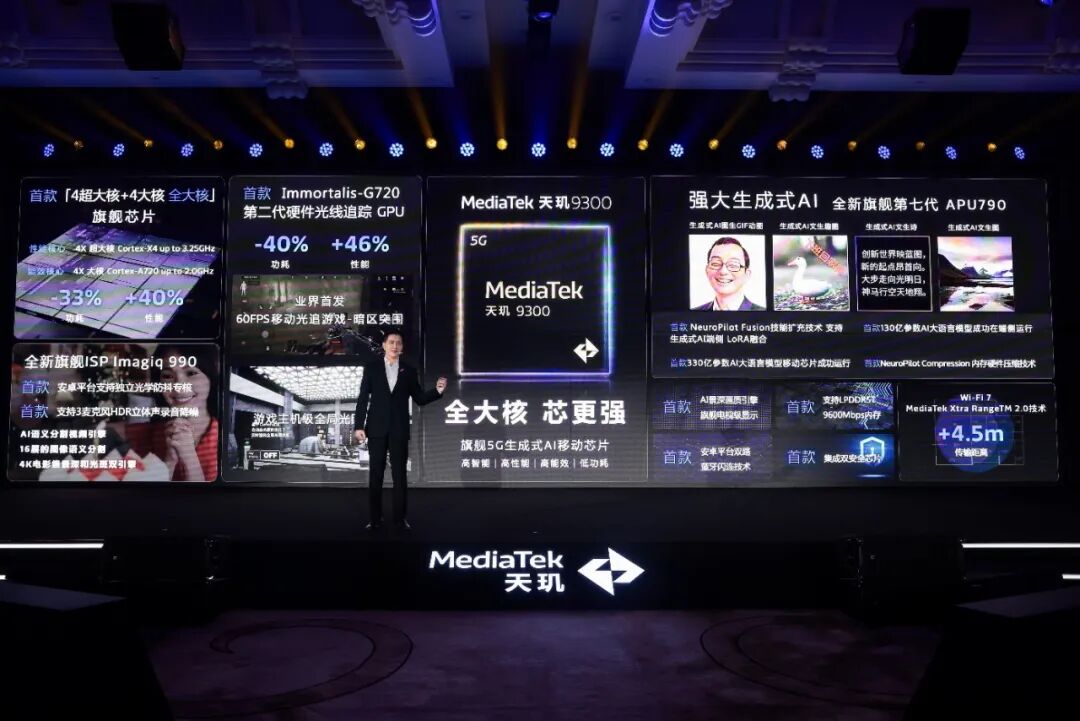 Why does “All Big Cores” represent a new direction for flagship chip performance?The transition of mobile chips from “single-core” to “multi-core” is actually aimed at better matching the performance demands of smartphone users.In this process, MediaTek and Qualcomm have engaged in a “battle of octa-core versus quad-core”. From the final outcome, it is clear that MediaTek is the winner: currently, most Android smartphones are equipped with octa-core chip architectures.However, with the continuous improvement of process and clock speed, the traditional octa-core “three cluster” or “four cluster” architecture has revealed an important issue: small cores do not save power, and big cores do not provide enough performance.Compared to the early days of the octa-core era, both the system and application layer designs, as well as user usage scenarios, have undergone significant changes.For example, in multitasking scenarios, big cores may cause application stuttering, background app termination, overheating, and reduced battery life due to insufficient performance. In cases where “scene intelligence” and health monitoring functions are continuously running, small cores, which were previously designated for “low power consumption scenarios”, often remain at full load due to their inherent performance limitations, which still reduces battery life for smartphone users.Thus, traditional octa-cores have become an awkward situation of “either insufficient performance or frequently sleeping big cores” and “still insufficient performance, with small cores running at overload for long periods”.This is actually one of the main reasons why major smartphone manufacturers are accelerating the development of their own co-processors.Apple has also recognized this situation; its A-series chips’ small cores are actually “not small” and are even larger than some Android octa-core big cores.Therefore, the “All Big Core” architecture of the Dimensity 9300 is not without “keen competitors”.However, unlike Apple’s self-use of the A-series processors, the implementation of the all-big-core architecture on the Android side involves overall architecture design at the chip level, collaborative innovation among major smartphone manufacturers, system-level optimization, and extensive application innovation and scenario implementation, which can be described as “pulling one hair and moving the whole body”.Why is MediaTek willing to take the lead in the “All Big Core” chip architecture?The reason is actually very simple: to fulfill its long-standing technical aspiration of “reaching the peak of flagship chips” and to become the “preferred flagship chip for major smartphone companies” in the industry.However, the upgrade from “big and small cores” to the “All Big Core” architecture is a typical case of “easy to know, hard to do“. The Dimensity 9300 not only leads the industry in achieving this but also manages to achieve “All Big Cores without wasting power“, even reaching the significant challenge of “high performance, equally low power consumption“. This is actually the result of MediaTek’s long-term investment, keen judgment, and collaborative innovation with the upstream and downstream of the industry chain.
Why does “All Big Cores” represent a new direction for flagship chip performance?The transition of mobile chips from “single-core” to “multi-core” is actually aimed at better matching the performance demands of smartphone users.In this process, MediaTek and Qualcomm have engaged in a “battle of octa-core versus quad-core”. From the final outcome, it is clear that MediaTek is the winner: currently, most Android smartphones are equipped with octa-core chip architectures.However, with the continuous improvement of process and clock speed, the traditional octa-core “three cluster” or “four cluster” architecture has revealed an important issue: small cores do not save power, and big cores do not provide enough performance.Compared to the early days of the octa-core era, both the system and application layer designs, as well as user usage scenarios, have undergone significant changes.For example, in multitasking scenarios, big cores may cause application stuttering, background app termination, overheating, and reduced battery life due to insufficient performance. In cases where “scene intelligence” and health monitoring functions are continuously running, small cores, which were previously designated for “low power consumption scenarios”, often remain at full load due to their inherent performance limitations, which still reduces battery life for smartphone users.Thus, traditional octa-cores have become an awkward situation of “either insufficient performance or frequently sleeping big cores” and “still insufficient performance, with small cores running at overload for long periods”.This is actually one of the main reasons why major smartphone manufacturers are accelerating the development of their own co-processors.Apple has also recognized this situation; its A-series chips’ small cores are actually “not small” and are even larger than some Android octa-core big cores.Therefore, the “All Big Core” architecture of the Dimensity 9300 is not without “keen competitors”.However, unlike Apple’s self-use of the A-series processors, the implementation of the all-big-core architecture on the Android side involves overall architecture design at the chip level, collaborative innovation among major smartphone manufacturers, system-level optimization, and extensive application innovation and scenario implementation, which can be described as “pulling one hair and moving the whole body”.Why is MediaTek willing to take the lead in the “All Big Core” chip architecture?The reason is actually very simple: to fulfill its long-standing technical aspiration of “reaching the peak of flagship chips” and to become the “preferred flagship chip for major smartphone companies” in the industry.However, the upgrade from “big and small cores” to the “All Big Core” architecture is a typical case of “easy to know, hard to do“. The Dimensity 9300 not only leads the industry in achieving this but also manages to achieve “All Big Cores without wasting power“, even reaching the significant challenge of “high performance, equally low power consumption“. This is actually the result of MediaTek’s long-term investment, keen judgment, and collaborative innovation with the upstream and downstream of the industry chain.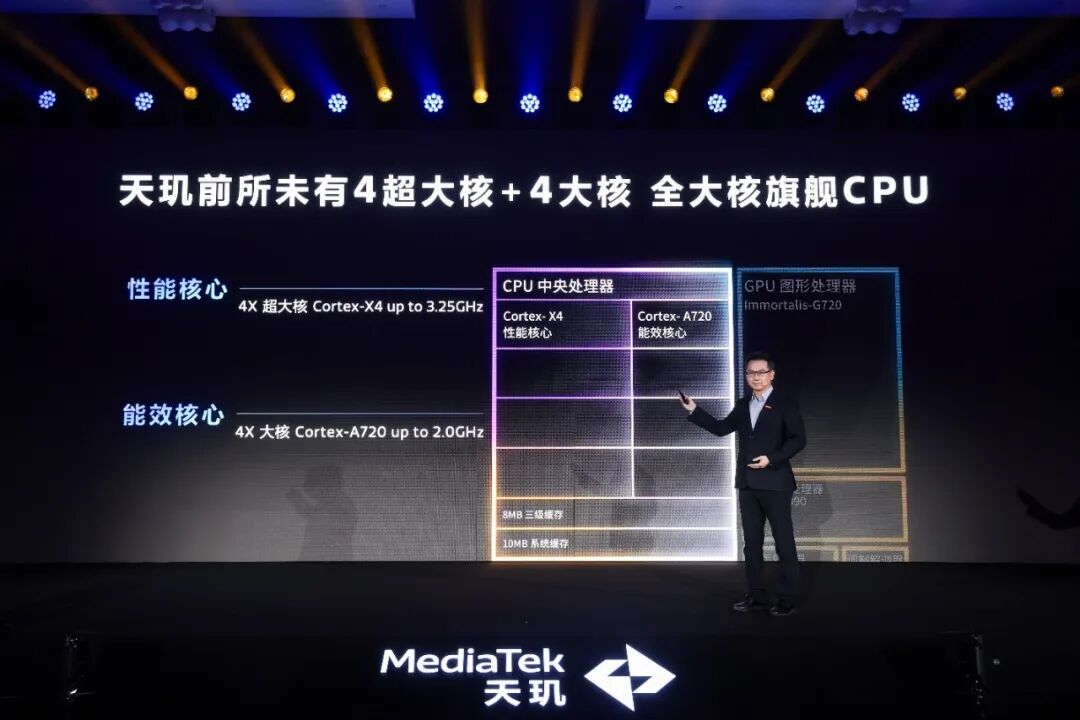 The Dimensity 9300 CPU features 4 Cortex-X4 cores with a maximum frequency of 3.25GHz, combined with 4 Cortex-A720 big cores with a frequency of 2.0GHz, forming a “4+4” architecture that completely eliminates the Cortex-A520 small cores. This is fundamentally different from previous traditional architectures such as “1+4+3” or “1+3+4”.Cortex-X4 and Cortex-A720 are both the latest third-generation ARMv9 CPU cores released by ARM in May this year, along with the DSU-120 (DynamIQ Shared Unit) and the flagship GPU Immortalis-G720. The third-generation ARMv9 CPU cores are characterized by higher performance and lower energy efficiency, while the DSU-120 is designed to meet the demanding requirements of multi-threaded usage scenarios.The “All Big Core” new architecture of the Dimensity 9300 also fully realizes the “exploitation potential” of the new cores: the peak CPU performance has increased by 40% compared to the previous generation, while power consumption has decreased by 33% — this is a leap compared to the traditional chip architecture’s performance “squeezing out generation by generation”.
The Dimensity 9300 CPU features 4 Cortex-X4 cores with a maximum frequency of 3.25GHz, combined with 4 Cortex-A720 big cores with a frequency of 2.0GHz, forming a “4+4” architecture that completely eliminates the Cortex-A520 small cores. This is fundamentally different from previous traditional architectures such as “1+4+3” or “1+3+4”.Cortex-X4 and Cortex-A720 are both the latest third-generation ARMv9 CPU cores released by ARM in May this year, along with the DSU-120 (DynamIQ Shared Unit) and the flagship GPU Immortalis-G720. The third-generation ARMv9 CPU cores are characterized by higher performance and lower energy efficiency, while the DSU-120 is designed to meet the demanding requirements of multi-threaded usage scenarios.The “All Big Core” new architecture of the Dimensity 9300 also fully realizes the “exploitation potential” of the new cores: the peak CPU performance has increased by 40% compared to the previous generation, while power consumption has decreased by 33% — this is a leap compared to the traditional chip architecture’s performance “squeezing out generation by generation”.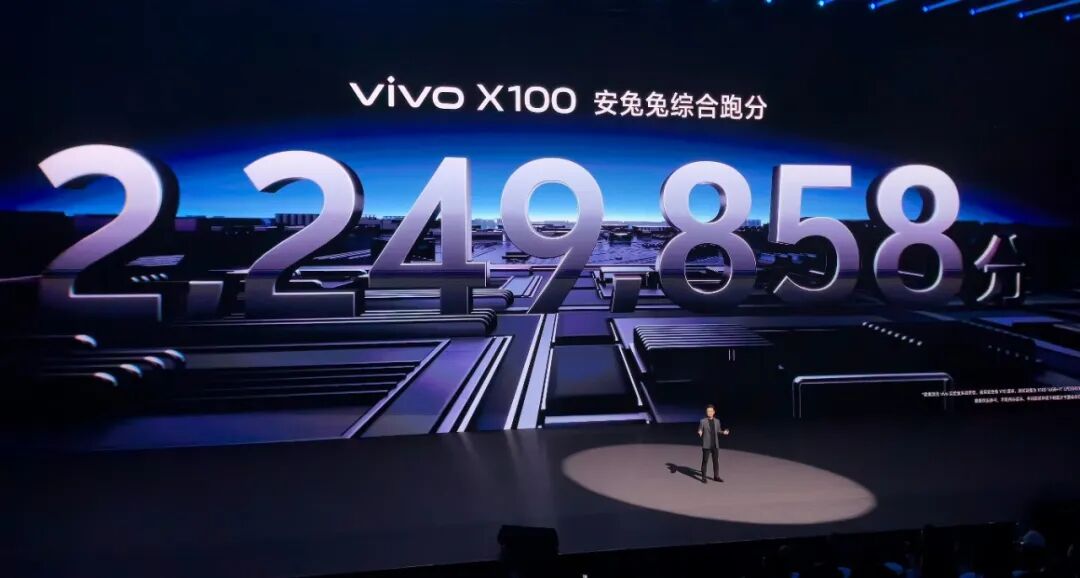 According to laboratory test data, the Dimensity 9300 achieved a maximum multi-core score of 8000 in Geekbench 6, significantly surpassing Apple’s A17 Pro released this year and Qualcomm’s recently released Snapdragon 8 Gen3. AnTuTu platform data shows that the X100 achieved a comprehensive score of 2249858 points at room temperature, and 2316765 points under laboratory conditions, continuously refreshing the industry’s and users’ perception of Dimensity’s “performance”.Equally important is that while “performance soars”, the Dimensity 9300’s “All Big Core” also performs “beyond expectations” in low power consumption, long battery life, and multitasking scenarios, which is crucial for enhancing flagship smartphone innovation and high-end user experience.Official speed test data shows that in daily usage scenarios, flagship smartphones equipped with the Dimensity 9300 have a maximum power consumption reduction of 30%, with power consumption reduced by about 11% in daily browsing and short video applications.In scenarios such as running the game “Genshin Impact” at 60FPS with ultra-high quality alongside WeChat video calls, the Dimensity 9300’s all-big-core architecture compared to the traditional architecture of the Dimensity 9200 has improved the average frame rate by 15.5% (“Genshin Impact” can run at full frame for 30 minutes), with an average power consumption reduction of 12.3%. In heavy multitasking scenarios where users watch videos while reading news on a foldable screen, the Dimensity 9300’s all-big-core can better leverage its multi-threading advantages, with actual test power consumption reduced by 11.2%, allowing for seamless switching between multi-screen applications and flexible performance adjustments.The Dimensity 9300 achieves “ultra-high performance, ultra-low power consumption” based on two outstanding capabilities:First, all eight big cores are out-of-order execution cores. Compared to the sequential execution logic of traditional CPUs, out-of-order execution allows for parallel computation based on user application priority without waiting for programs to execute one by one in order, thereby increasing the “rest” time of big cores by improving the efficiency of operations per unit time. In MediaTek’s words, it means “doing faster, resting faster, and consuming less power”.Chen Lifeng, Senior Manager of MediaTek’s Wireless Communication Division, stated: “One E core (A720) of the Dimensity 9300 can cover most of the workload of one big core + one small core of the Dimensity 9200, with better performance and power consumption. Similarly, the P core (X4 super big core) of the Dimensity 9300 also outperforms the super big core of the Dimensity 9200 in terms of energy efficiency.”For users, achieving higher performance with the same power consumption means executing more tasks while also considering the battery life of terminal devices, resulting in fewer application overload stutters and multitasking delays. Moreover, this advantage will be further enhanced with algorithm upgrades that more accurately identify application priorities and the actual needs of users in different scenarios, continuously improving the computational efficiency and “performance redundancy” of smartphones.The second is the continuous iterative support of TSMC’s advanced 4nm process. Although it is also a 4nm process, the performance from the inside out is different. The Dimensity 9300 has an astonishing transistor scale of 22.7 billion, even higher than Apple’s A17 Pro’s 19 billion (Qualcomm has not disclosed this data yet).
According to laboratory test data, the Dimensity 9300 achieved a maximum multi-core score of 8000 in Geekbench 6, significantly surpassing Apple’s A17 Pro released this year and Qualcomm’s recently released Snapdragon 8 Gen3. AnTuTu platform data shows that the X100 achieved a comprehensive score of 2249858 points at room temperature, and 2316765 points under laboratory conditions, continuously refreshing the industry’s and users’ perception of Dimensity’s “performance”.Equally important is that while “performance soars”, the Dimensity 9300’s “All Big Core” also performs “beyond expectations” in low power consumption, long battery life, and multitasking scenarios, which is crucial for enhancing flagship smartphone innovation and high-end user experience.Official speed test data shows that in daily usage scenarios, flagship smartphones equipped with the Dimensity 9300 have a maximum power consumption reduction of 30%, with power consumption reduced by about 11% in daily browsing and short video applications.In scenarios such as running the game “Genshin Impact” at 60FPS with ultra-high quality alongside WeChat video calls, the Dimensity 9300’s all-big-core architecture compared to the traditional architecture of the Dimensity 9200 has improved the average frame rate by 15.5% (“Genshin Impact” can run at full frame for 30 minutes), with an average power consumption reduction of 12.3%. In heavy multitasking scenarios where users watch videos while reading news on a foldable screen, the Dimensity 9300’s all-big-core can better leverage its multi-threading advantages, with actual test power consumption reduced by 11.2%, allowing for seamless switching between multi-screen applications and flexible performance adjustments.The Dimensity 9300 achieves “ultra-high performance, ultra-low power consumption” based on two outstanding capabilities:First, all eight big cores are out-of-order execution cores. Compared to the sequential execution logic of traditional CPUs, out-of-order execution allows for parallel computation based on user application priority without waiting for programs to execute one by one in order, thereby increasing the “rest” time of big cores by improving the efficiency of operations per unit time. In MediaTek’s words, it means “doing faster, resting faster, and consuming less power”.Chen Lifeng, Senior Manager of MediaTek’s Wireless Communication Division, stated: “One E core (A720) of the Dimensity 9300 can cover most of the workload of one big core + one small core of the Dimensity 9200, with better performance and power consumption. Similarly, the P core (X4 super big core) of the Dimensity 9300 also outperforms the super big core of the Dimensity 9200 in terms of energy efficiency.”For users, achieving higher performance with the same power consumption means executing more tasks while also considering the battery life of terminal devices, resulting in fewer application overload stutters and multitasking delays. Moreover, this advantage will be further enhanced with algorithm upgrades that more accurately identify application priorities and the actual needs of users in different scenarios, continuously improving the computational efficiency and “performance redundancy” of smartphones.The second is the continuous iterative support of TSMC’s advanced 4nm process. Although it is also a 4nm process, the performance from the inside out is different. The Dimensity 9300 has an astonishing transistor scale of 22.7 billion, even higher than Apple’s A17 Pro’s 19 billion (Qualcomm has not disclosed this data yet). MediaTek’s Wireless Communication Division Product Planning Director Zhang Genghao revealed that as one of TSMC’s top three global customers, MediaTek’s third-generation 4nm process has received full optimization support in efficiency adjustments. For example, in the critical area of leakage rate optimization, “the Dimensity 9300 is ahead of competitors by half a generation or even a generation”.In other words, the “All Big Core new architecture design” of the Dimensity 9300 seems to be “fantastical”, but it is not “conjured out of thin air”, nor is it merely a “marketing gimmick”; it represents a new evolutionary roadmap for global chips to break performance bottlenecks. The significant investments and returns in the semiconductor industry towards advanced processes, along with the current “scissors gap” industry situation, will further accelerate the “All Big Core” becoming a new standard for the entire industry.Zhang Genghao stated: “All Big Cores” provide a new standard and innovation direction for the entire chip and smartphone industry, and the future will definitely be the “All Big Core era”.The Dimensity 9300 Accelerates the Evolution of the New Landscape for Flagship SmartphonesThe Chinese smartphone market experiences a “cyclical change” in market structure approximately every five years.This is related to the iteration of communication technologies and is directly influenced by the insights and innovative strategies of major smartphone companies regarding technological trends and user demands. For example, from the explosive growth of smartphones in China in 2011 to now, the market structure has undergone at least three significant changes, and in 2023, it has reached a critical turning point again. For instance, the market share and brand growth from the beginning to the end of the year are already significantly different.However, the “unchanging amidst change” is the important driving role of chips as “core technology” in promoting innovation in smartphones and the evolution of market structures.With the release of the Dimensity 9300, we can see that MediaTek has broken through “three ceilings”, bringing three major variables to smartphone market innovation and structural shifts.First, it addresses the urgent demand of high-end users for flagship smartphones that “need (performance), need (battery life), and need (smoothness)”.In addition to the disruptive characteristics of “ultra-high performance, ultra-low power consumption” brought by the “All Big Core” new architecture, MediaTek has also driven flagship innovation to meet the differentiated needs of high-end users through joint innovation and support customization with smartphone companies.Taking the vivo X100 series, which first launched with the Dimensity 9300, as an example, it is understood that both parties began exploring the direction of “All Big Cores” together two years ago. This also means that vivo and MediaTek have moved from the “joint tuning” of the Dimensity 9000, the “joint development” of the Dimensity 9200, to the current “joint definition” of the Dimensity 9300. The benefits are also very clear: the Dimensity 9300 can respond more quickly to the needs of smartphone partners, align more closely with the preferences of the general user base, and thus adjust its chip strategy, pace, and functional characteristics more flexibly. This is crucial in the current global smartphone market, which is trapped in “homogenization” and a “slow innovation cycle” backdrop.MediaTek’s Director and General Manager Chen Guanzhou stated: From the Dimensity 9000, Dimensity 9200 to Dimensity 9300, from the flagship starting point of Dimensity to standing firm at the top, vivo and MediaTek have been working together in the flagship market for three years. Both parties have established a joint research and development laboratory to collaboratively enhance user experience across multiple fields such as performance, imaging, gaming, and AI. Vivo and MediaTek decided early on to explore the All Big Core era together. Through the close cooperation of the Dimensity and vivo’s blue crystal chip technology stack, consumers are provided with a more intelligent, smoother, and cooler ultimate flagship experience, resulting in the vivo X100 series being a “perfect flagship”.Second, it strongly supports the deep innovation and accelerated popularization aspirations of various smartphone brands in the large model field.“Large models” have become one of the hottest “keywords” in the global technology industry this year. Since August, major domestic smartphone companies have launched their own large models or related strategies, further intensifying the performance shortfall in edge-side computing power.The Dimensity 9300 is also a 5G flagship processor “designed for generative AI”. Its APU has been iterated to the seventh generation, focusing on three major pain points faced by large AI models running on terminals: slow generation speed, memory limitations, and limited number of large models.The APU 790 architecture design not only includes a hardware-level generative AI engine and a general-purpose AI acceleration core but also features a high-performance AI core optimized for the core Softmax + LayerNorm operators used in generative AI models, achieving processing speeds up to eight times that of the previous generation APU, with a generation speed of 20 tokens per second for a large language model with 7 billion parameters, capable of generating images from text in under one second. The APU 790 also supports mixed-precision INT4 quantization technology, with both integer and floating-point performance being twice that of the previous generation APU, while power consumption has been reduced by 45%.
MediaTek’s Wireless Communication Division Product Planning Director Zhang Genghao revealed that as one of TSMC’s top three global customers, MediaTek’s third-generation 4nm process has received full optimization support in efficiency adjustments. For example, in the critical area of leakage rate optimization, “the Dimensity 9300 is ahead of competitors by half a generation or even a generation”.In other words, the “All Big Core new architecture design” of the Dimensity 9300 seems to be “fantastical”, but it is not “conjured out of thin air”, nor is it merely a “marketing gimmick”; it represents a new evolutionary roadmap for global chips to break performance bottlenecks. The significant investments and returns in the semiconductor industry towards advanced processes, along with the current “scissors gap” industry situation, will further accelerate the “All Big Core” becoming a new standard for the entire industry.Zhang Genghao stated: “All Big Cores” provide a new standard and innovation direction for the entire chip and smartphone industry, and the future will definitely be the “All Big Core era”.The Dimensity 9300 Accelerates the Evolution of the New Landscape for Flagship SmartphonesThe Chinese smartphone market experiences a “cyclical change” in market structure approximately every five years.This is related to the iteration of communication technologies and is directly influenced by the insights and innovative strategies of major smartphone companies regarding technological trends and user demands. For example, from the explosive growth of smartphones in China in 2011 to now, the market structure has undergone at least three significant changes, and in 2023, it has reached a critical turning point again. For instance, the market share and brand growth from the beginning to the end of the year are already significantly different.However, the “unchanging amidst change” is the important driving role of chips as “core technology” in promoting innovation in smartphones and the evolution of market structures.With the release of the Dimensity 9300, we can see that MediaTek has broken through “three ceilings”, bringing three major variables to smartphone market innovation and structural shifts.First, it addresses the urgent demand of high-end users for flagship smartphones that “need (performance), need (battery life), and need (smoothness)”.In addition to the disruptive characteristics of “ultra-high performance, ultra-low power consumption” brought by the “All Big Core” new architecture, MediaTek has also driven flagship innovation to meet the differentiated needs of high-end users through joint innovation and support customization with smartphone companies.Taking the vivo X100 series, which first launched with the Dimensity 9300, as an example, it is understood that both parties began exploring the direction of “All Big Cores” together two years ago. This also means that vivo and MediaTek have moved from the “joint tuning” of the Dimensity 9000, the “joint development” of the Dimensity 9200, to the current “joint definition” of the Dimensity 9300. The benefits are also very clear: the Dimensity 9300 can respond more quickly to the needs of smartphone partners, align more closely with the preferences of the general user base, and thus adjust its chip strategy, pace, and functional characteristics more flexibly. This is crucial in the current global smartphone market, which is trapped in “homogenization” and a “slow innovation cycle” backdrop.MediaTek’s Director and General Manager Chen Guanzhou stated: From the Dimensity 9000, Dimensity 9200 to Dimensity 9300, from the flagship starting point of Dimensity to standing firm at the top, vivo and MediaTek have been working together in the flagship market for three years. Both parties have established a joint research and development laboratory to collaboratively enhance user experience across multiple fields such as performance, imaging, gaming, and AI. Vivo and MediaTek decided early on to explore the All Big Core era together. Through the close cooperation of the Dimensity and vivo’s blue crystal chip technology stack, consumers are provided with a more intelligent, smoother, and cooler ultimate flagship experience, resulting in the vivo X100 series being a “perfect flagship”.Second, it strongly supports the deep innovation and accelerated popularization aspirations of various smartphone brands in the large model field.“Large models” have become one of the hottest “keywords” in the global technology industry this year. Since August, major domestic smartphone companies have launched their own large models or related strategies, further intensifying the performance shortfall in edge-side computing power.The Dimensity 9300 is also a 5G flagship processor “designed for generative AI”. Its APU has been iterated to the seventh generation, focusing on three major pain points faced by large AI models running on terminals: slow generation speed, memory limitations, and limited number of large models.The APU 790 architecture design not only includes a hardware-level generative AI engine and a general-purpose AI acceleration core but also features a high-performance AI core optimized for the core Softmax + LayerNorm operators used in generative AI models, achieving processing speeds up to eight times that of the previous generation APU, with a generation speed of 20 tokens per second for a large language model with 7 billion parameters, capable of generating images from text in under one second. The APU 790 also supports mixed-precision INT4 quantization technology, with both integer and floating-point performance being twice that of the previous generation APU, while power consumption has been reduced by 45%.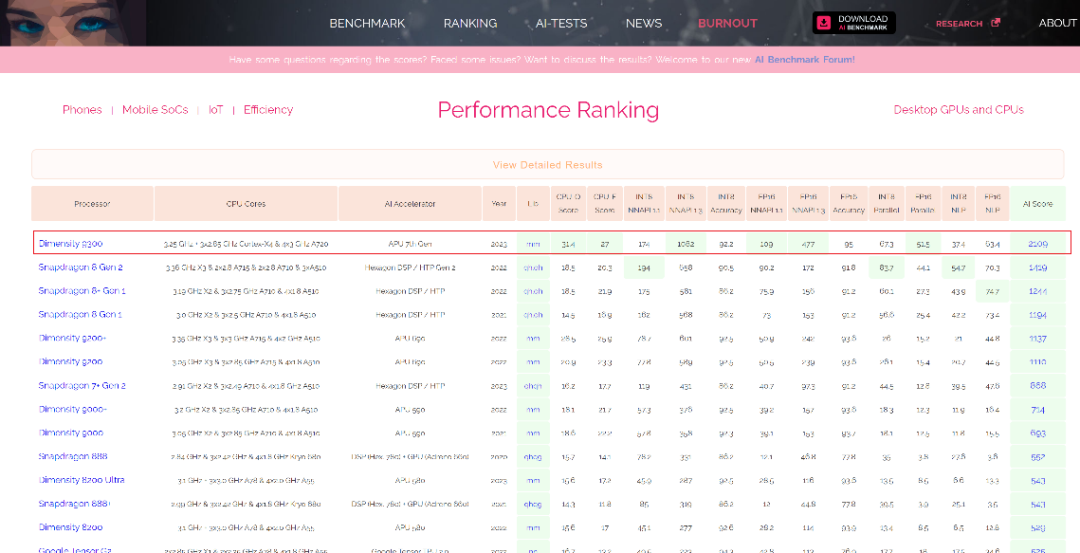 Currently, the Dimensity 9300 has successfully run AI large models with up to 33 billion parameters (based on smartphones with 24GB of memory). Generally, the higher the parameters of a large model, the stronger the AI capability. In contrast, the Snapdragon 8 Gen3 can only support edge-side large models with up to 13 billion parameters. According to the AI Benchmark v5.1 Mobile SoC test released by ETH Zurich, the Dimensity 9000 achieved a good score of 2109, ranking first.Another major pain point for edge-side large models is that they occupy too much running memory space. For example, a 13 billion parameter AI large model requires about 13GB of memory to run, while the Android operating system itself typically occupies 4GB of memory, plus the memory required for other applications, making it impossible for even current flagship smartphones to meet this demand. The APU 790 features MediaTek’s unique memory hardware compression technology (NeuroPilot Compression), which can reduce the memory footprint of AI large models by 61%. Taking a 13 billion parameter large model as an example, the required memory capacity is only about 5GB, which is manageable for many “lightweight large models”. For instance, MediaTek and vivo have jointly achieved the deployment of a 7 billion parameter large language model on the edge and have also realized the operation of a 13 billion large language model on the edge.
Currently, the Dimensity 9300 has successfully run AI large models with up to 33 billion parameters (based on smartphones with 24GB of memory). Generally, the higher the parameters of a large model, the stronger the AI capability. In contrast, the Snapdragon 8 Gen3 can only support edge-side large models with up to 13 billion parameters. According to the AI Benchmark v5.1 Mobile SoC test released by ETH Zurich, the Dimensity 9000 achieved a good score of 2109, ranking first.Another major pain point for edge-side large models is that they occupy too much running memory space. For example, a 13 billion parameter AI large model requires about 13GB of memory to run, while the Android operating system itself typically occupies 4GB of memory, plus the memory required for other applications, making it impossible for even current flagship smartphones to meet this demand. The APU 790 features MediaTek’s unique memory hardware compression technology (NeuroPilot Compression), which can reduce the memory footprint of AI large models by 61%. Taking a 13 billion parameter large model as an example, the required memory capacity is only about 5GB, which is manageable for many “lightweight large models”. For instance, MediaTek and vivo have jointly achieved the deployment of a 7 billion parameter large language model on the edge and have also realized the operation of a 13 billion large language model on the edge.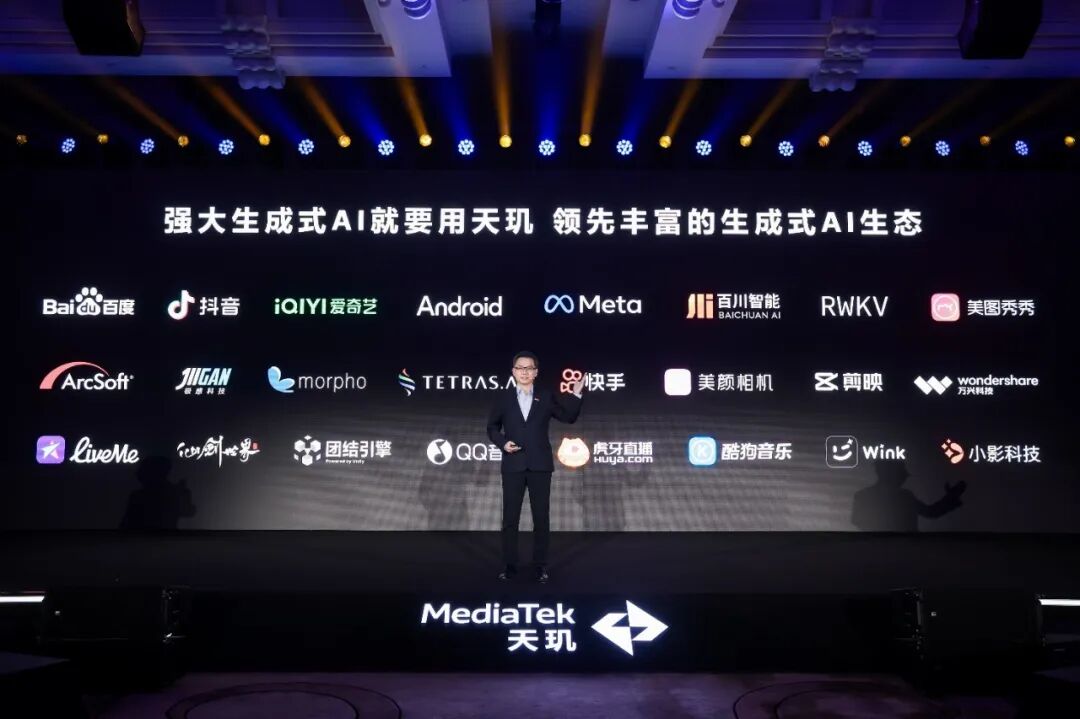 This addresses the industry’s initial challenges of “few large models and single functions”. The APU 790 equipped with NeuroPilot Fusion has a unique generative I model edge-side “skill expansion” technology, which can quickly and efficiently expand various generative AI applications and functions needed by end users after performing low-rank adaptation (LoRA) fusion on the edge. Currently, MediaTek’s edge-side generative AI has over 20 partners, including Google, Meta, Baidu, Baichuan, Douyin, Kuaishou, Huya, iQIYI, Meitu, etc. NeuroPilot has supported mainstream AI large models such as Meta’s LLaMA 2, Baidu’s Wenxin Yiyan large model, and Baichuan’s Baichuan large model, providing a complete toolchain to help developers efficiently develop and deploy text, image, music, and other multimodal generative AI applications on smartphones and other terminals.MediaTek’s Senior Manager of AI Technology in the Wireless Communication Division, Zhuang Shiyong, emphasized that MediaTek has been laying out in the edge-side AI large model field for many years, and MediaTek does not want edge-side large models to be just a single service for users, but a comprehensive intelligent experience revolution. Therefore, it hopes to lead the entire edge-side generative AI service, with the NeuroPilot generative AI development platform providing developers and partners with a rich “skill package” to quickly upgrade this foundational large model to various AI functional services required by users.Third, it meets the leap in experience needs for high-frequency essentials such as imaging, gaming, and display scenarios for smartphone users.As MediaTek’s top flagship chip, the Dimensity 9300’s various new technologies and configurations are indeed “fully loaded”.For example, the Dimensity 9300 first adopts Arm’s latest generation flagship 12-core GPU Immortalis-G720, with peak performance increased by 46% and power consumption reduced by 40%. In the GFXBench v5.0.5 1440P Aztec Ruins Vulkan test, the Dimensity 9300’s GPU performance score was 99FPS, surpassing both the Snapdragon 8 Gen3 and Apple’s A17 Pro. In the GFXBench v5.0.5 1080P Manhattan 3.1 test, the Dimensity 9300 scored as high as 344FPS, leading Qualcomm’s Snapdragon 8 Gen3 by about 23%.
This addresses the industry’s initial challenges of “few large models and single functions”. The APU 790 equipped with NeuroPilot Fusion has a unique generative I model edge-side “skill expansion” technology, which can quickly and efficiently expand various generative AI applications and functions needed by end users after performing low-rank adaptation (LoRA) fusion on the edge. Currently, MediaTek’s edge-side generative AI has over 20 partners, including Google, Meta, Baidu, Baichuan, Douyin, Kuaishou, Huya, iQIYI, Meitu, etc. NeuroPilot has supported mainstream AI large models such as Meta’s LLaMA 2, Baidu’s Wenxin Yiyan large model, and Baichuan’s Baichuan large model, providing a complete toolchain to help developers efficiently develop and deploy text, image, music, and other multimodal generative AI applications on smartphones and other terminals.MediaTek’s Senior Manager of AI Technology in the Wireless Communication Division, Zhuang Shiyong, emphasized that MediaTek has been laying out in the edge-side AI large model field for many years, and MediaTek does not want edge-side large models to be just a single service for users, but a comprehensive intelligent experience revolution. Therefore, it hopes to lead the entire edge-side generative AI service, with the NeuroPilot generative AI development platform providing developers and partners with a rich “skill package” to quickly upgrade this foundational large model to various AI functional services required by users.Third, it meets the leap in experience needs for high-frequency essentials such as imaging, gaming, and display scenarios for smartphone users.As MediaTek’s top flagship chip, the Dimensity 9300’s various new technologies and configurations are indeed “fully loaded”.For example, the Dimensity 9300 first adopts Arm’s latest generation flagship 12-core GPU Immortalis-G720, with peak performance increased by 46% and power consumption reduced by 40%. In the GFXBench v5.0.5 1440P Aztec Ruins Vulkan test, the Dimensity 9300’s GPU performance score was 99FPS, surpassing both the Snapdragon 8 Gen3 and Apple’s A17 Pro. In the GFXBench v5.0.5 1080P Manhattan 3.1 test, the Dimensity 9300 scored as high as 344FPS, leading Qualcomm’s Snapdragon 8 Gen3 by about 23%.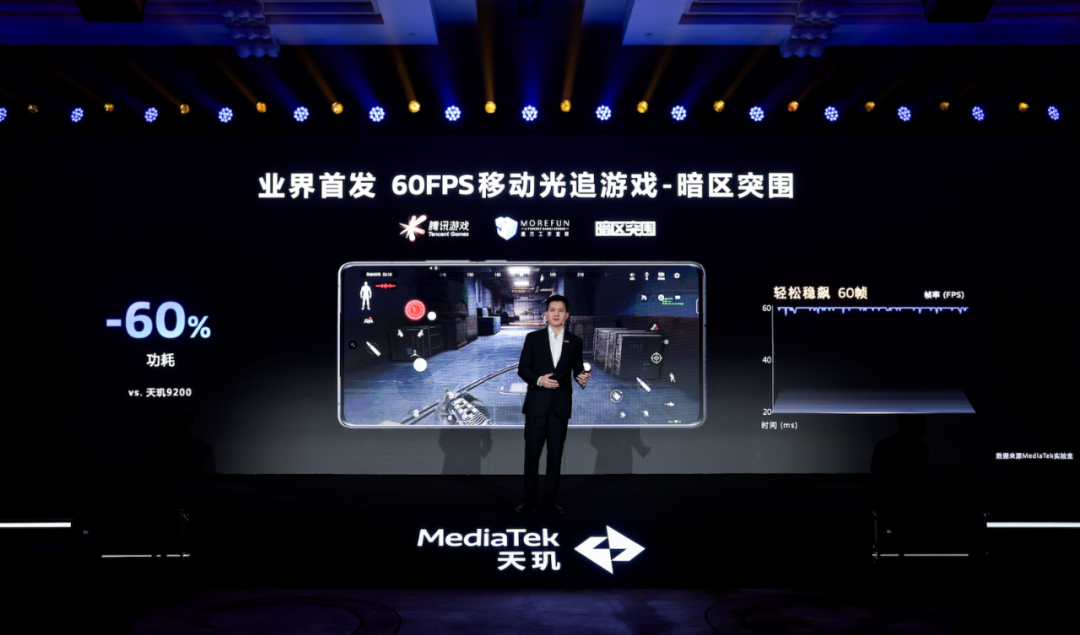 The direct experience for users is that in “Genshin Impact” at 60 frames with ultra-high quality, it can run at full frame for 30 minutes, while the game’s special speed has increased by 25%, and average power consumption has decreased by 20%. MediaTek also announced that the Dimensity 9300 platform will be the first in the industry to launch the 60FPS mobile ray tracing game “Escape from Tarkov”, which can easily and stably maintain 60FPS, with game power consumption reduced by 60% compared to the previous generation. In addition, the Dimensity 9300 has also brought console-level global illumination effects to smartphones, which is one of the biggest technological breakthroughs that users have long awaited in mobile gaming.In terms of imaging, the Dimensity 9300 is equipped with a flagship ISP image processor Imagiq 990, supporting full-pixel focus overlay 2x lossless zoom function, and cinematic light and shadow effects during 4K video recording. According to the information already released about the vivo X100 series, the powerful imaging computing power formed by its self-developed imaging chip V3 and the Dimensity 9300’s “dual-chip collaboration” has enabled the vivo X100 series to achieve the first-ever 4K/30fps cinematic portrait video shooting on a smartphone, as well as 4K-level “post-editing” functionality, marking a significant breakthrough for the entire Android flagship imaging.Furthermore, the Dimensity 9300 also leads in innovation technologies in display, 5G communication, Wi-Fi 7 wireless connectivity, and data security. This positions MediaTek not only to form a true mobile flagship SoC triumvirate with Apple’s A17 Pro and Qualcomm’s Snapdragon 8 Gen3 in the new round of critical node evolution in the smartphone market from 2023 to 2024, but also to become an important “core engine” for top smartphone companies to create differentiated flagship experiences and accelerate the overall market’s bottoming rebound.Chen Guanzhou stated: The Dimensity 9300 was designed from the outset with the goal of being “the flagship first”. It not only possesses powerful performance and extreme energy efficiency but also carries many cutting-edge technologies accumulated by MediaTek over more than 20 years. A week after its release, it has received numerous accolades from the media, including “the strongest Android SoC“. “Flagship first, the Dimensity 9300 lives up to its name“.This is likely also the reason why at the Dimensity 9300 launch event, vivo’s Senior Vice President and CTO Shi Yujian announced the new X100 series flagship smartphone will debut with the Dimensity 9300, OPPO’s Vice President Duan Yaohui announced that the upcoming Find X7 flagship smartphone will adopt the Dimensity 9300, and Xiaomi Group’s Senior Vice President and President of the Mobile Division Zeng Xuezhong expressed the importance of deep strategic partnerships across multiple fields.Comments from “Yi Observation”MediaTek’s Dimensity 9300, which has been “three years in the making”, is also an important window period for domestic smartphone companies to “collectively strive for high-end”.It can be said that the goal of the Dimensity 9300 project from the beginning was to better enable major smartphone companies to “shine in the high-end market”.From this perspective, it is easier to understand why MediaTek is willing to invest heavily in the new generation of all-big-core chip architecture and why it has packed the Dimensity 9300 with cutting-edge technologies.
The direct experience for users is that in “Genshin Impact” at 60 frames with ultra-high quality, it can run at full frame for 30 minutes, while the game’s special speed has increased by 25%, and average power consumption has decreased by 20%. MediaTek also announced that the Dimensity 9300 platform will be the first in the industry to launch the 60FPS mobile ray tracing game “Escape from Tarkov”, which can easily and stably maintain 60FPS, with game power consumption reduced by 60% compared to the previous generation. In addition, the Dimensity 9300 has also brought console-level global illumination effects to smartphones, which is one of the biggest technological breakthroughs that users have long awaited in mobile gaming.In terms of imaging, the Dimensity 9300 is equipped with a flagship ISP image processor Imagiq 990, supporting full-pixel focus overlay 2x lossless zoom function, and cinematic light and shadow effects during 4K video recording. According to the information already released about the vivo X100 series, the powerful imaging computing power formed by its self-developed imaging chip V3 and the Dimensity 9300’s “dual-chip collaboration” has enabled the vivo X100 series to achieve the first-ever 4K/30fps cinematic portrait video shooting on a smartphone, as well as 4K-level “post-editing” functionality, marking a significant breakthrough for the entire Android flagship imaging.Furthermore, the Dimensity 9300 also leads in innovation technologies in display, 5G communication, Wi-Fi 7 wireless connectivity, and data security. This positions MediaTek not only to form a true mobile flagship SoC triumvirate with Apple’s A17 Pro and Qualcomm’s Snapdragon 8 Gen3 in the new round of critical node evolution in the smartphone market from 2023 to 2024, but also to become an important “core engine” for top smartphone companies to create differentiated flagship experiences and accelerate the overall market’s bottoming rebound.Chen Guanzhou stated: The Dimensity 9300 was designed from the outset with the goal of being “the flagship first”. It not only possesses powerful performance and extreme energy efficiency but also carries many cutting-edge technologies accumulated by MediaTek over more than 20 years. A week after its release, it has received numerous accolades from the media, including “the strongest Android SoC“. “Flagship first, the Dimensity 9300 lives up to its name“.This is likely also the reason why at the Dimensity 9300 launch event, vivo’s Senior Vice President and CTO Shi Yujian announced the new X100 series flagship smartphone will debut with the Dimensity 9300, OPPO’s Vice President Duan Yaohui announced that the upcoming Find X7 flagship smartphone will adopt the Dimensity 9300, and Xiaomi Group’s Senior Vice President and President of the Mobile Division Zeng Xuezhong expressed the importance of deep strategic partnerships across multiple fields.Comments from “Yi Observation”MediaTek’s Dimensity 9300, which has been “three years in the making”, is also an important window period for domestic smartphone companies to “collectively strive for high-end”.It can be said that the goal of the Dimensity 9300 project from the beginning was to better enable major smartphone companies to “shine in the high-end market”.From this perspective, it is easier to understand why MediaTek is willing to invest heavily in the new generation of all-big-core chip architecture and why it has packed the Dimensity 9300 with cutting-edge technologies. For MediaTek itself, after becoming the world’s largest smartphone SoC market share leader for three consecutive years, it urgently needs a peak processor that “surpasses old rivals” to further enhance the Dimensity series’ status as a “high-end flagship chip” among partner smartphone companies and the general consumer base.The birth of the Dimensity 9300, along with its many “breakthrough” characteristics, is indeed timely.From the perspective of the entire smartphone industry, the “All Big Core” architecture of the Dimensity 9300 is a further “disruptive” innovation by MediaTek after winning the “multi-core architecture battle”. It reflects MediaTek’s strong drive for technological innovation and demonstrates its accurate insight into the high-end user demands of smartphones and the innovation needs of smartphone companies.
For MediaTek itself, after becoming the world’s largest smartphone SoC market share leader for three consecutive years, it urgently needs a peak processor that “surpasses old rivals” to further enhance the Dimensity series’ status as a “high-end flagship chip” among partner smartphone companies and the general consumer base.The birth of the Dimensity 9300, along with its many “breakthrough” characteristics, is indeed timely.From the perspective of the entire smartphone industry, the “All Big Core” architecture of the Dimensity 9300 is a further “disruptive” innovation by MediaTek after winning the “multi-core architecture battle”. It reflects MediaTek’s strong drive for technological innovation and demonstrates its accurate insight into the high-end user demands of smartphones and the innovation needs of smartphone companies.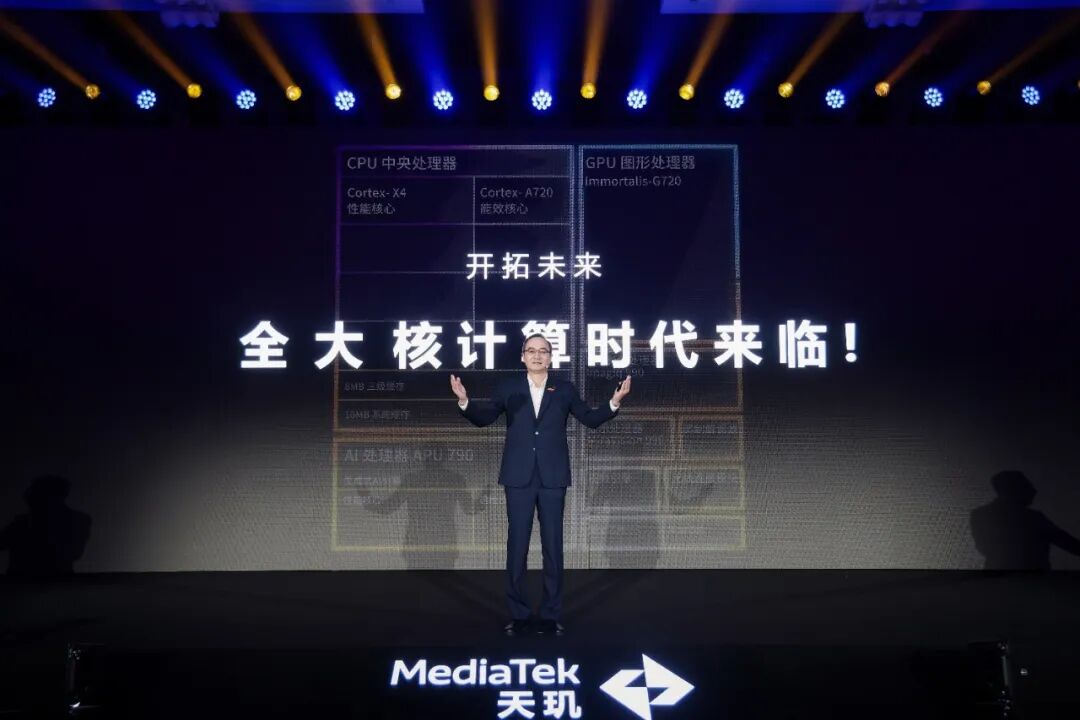 More importantly, according to the chip industry’s characteristics of “mass production for one generation, testing for one generation, and pre-research for one generation” with high investment and long cycles, the Dimensity 9300 not only becomes a major leader in chip technology breakthroughs but also its “All Big Core” architecture advantage will lead “old rivals” by 1-2 generations. This means that MediaTek has not only achieved the “strongest Android flagship, Dimensity chip” but has also realized “leading beyond levels”, which is particularly important in the current competitive landscape of flagship markets and the leap in large model technology.This is also the significant meaning of MediaTek’s current “redefining high-end chips“.
More importantly, according to the chip industry’s characteristics of “mass production for one generation, testing for one generation, and pre-research for one generation” with high investment and long cycles, the Dimensity 9300 not only becomes a major leader in chip technology breakthroughs but also its “All Big Core” architecture advantage will lead “old rivals” by 1-2 generations. This means that MediaTek has not only achieved the “strongest Android flagship, Dimensity chip” but has also realized “leading beyond levels”, which is particularly important in the current competitive landscape of flagship markets and the leap in large model technology.This is also the significant meaning of MediaTek’s current “redefining high-end chips“.
END
Founder of “Yi Observation” Su Yi
Former Chief Editor of Sohu Technology Communications
Search “Yi Observation” on Toutiao, Tencent News, Sohu Search
Search “Su Yi” on Baijiahao, Weibo, Douyin for more
丨Smart Hardware丨Communication丨New Retail丨Artificial Intelligence丨
丨Smart Internet of Vehicles丨Smart Home丨
For reprints and cooperation, contact WeChat: yiguancha_01